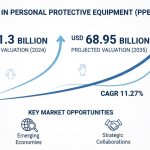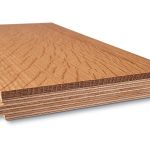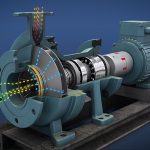Next-Gen Protection: Ballistics Composites Market Forecast Highlights Explosive Growth Amid Rising Defense and Aerospace Investments
According to analysts at Vantage Market Research, the Global Ballistics Composites Market size is worth USD 1.95 Billion in 2024 and is projected to reach USD 4.79 Billion by 2035, growing at a CAGR (Compound Annual Growth Rate) of 8.5% from 2025 to 2035. The key trends include increasing adoption of lightweight armor, advancements in nanocomposite materials, rising demand for multi-functional protection, growing military modernization programs, and expanding applications in law enforcement and security.
Our comprehensive Ballistics Composites Market report is ready with the latest trends, growth opportunities, and strategic analysis. View Sample Report PDF.
Key Takeaways from the Report
- North America dominated the market with 40.1% of market share in 2024. The region market is driven by a high number of military and law enforcement personnel and substantial defense budgets
- Based on the Fiber Type, the Aramid Fiber category accounted for significant market share in 2024. Aramid fibers are among the most widely used materials in ballistic composites due to their exceptional strength-to-weight ratio, heat resistance, and durability
- In 2024, by Product Type, Vehicle Armor dominated the market with significant market share of 39.5%
- By Matrix Type, Polymer Matrix dominated the market with significant market share of 48.6% in 2024. The segment is driven by its lightweight nature and high-performance capabilities
- Based on Application, the Defense & Military category accounted for significant market share in 2024. The Ballistics Composites materials are crucial for enhancing soldier protection, military vehicles, and aircraft
Premium Insights
The Ballistics Composites Market encompasses materials designed to absorb and dissipate the energy from ballistic impacts. These composites are typically made from fibers like aramid, UHMWPE, and carbon, embedded in a polymer matrix. The demand for these materials is fueled by the need for enhanced protection in various sectors, including defense, law enforcement, and aerospace.
Key Market Trends & Insights
- Material Innovation: The development of advanced fibers and matrices is leading to composites with superior ballistic resistance and reduced weight.
- Customization: Tailored solutions for specific applications, such as vehicle armor or personal protective equipment, are becoming more prevalent.
- Sustainability: There is a growing emphasis on eco-friendly materials and manufacturing processes in the production of ballistic composites.
Market Size & Forecast
- 2024: USD 1.95 billion
- 2035: USD 4.79 billion
- CAGR (2025–2035): 8.5%
The Ballistics Composites Market is moderately concentrated, with a few key players dominating the industry. However, the market is witnessing increased participation from new entrants, driven by technological advancements and the growing demand for protective materials.
For Ballistics Composites Market Research Report and updates detailed: View Full Report Now!
Strategic Goals for 2026
- Honeywell International Inc.
- Objective: Enhance the performance and sustainability of ballistic composites.
- Strategy: Invest in R&D to develop advanced aramid fiber technologies that offer superior protection while reducing environmental impact.
- Focus Areas: Improving strength-to-weight ratios and integrating sustainable materials into product lines.
- Teijin Limited
- Objective: Expand global market share in ballistic composites.
- Strategy: Leverage existing partnerships and explore new collaborations to increase production capacity and market reach.
- Focus Areas: Enhancing product offerings in personal protection equipment and vehicle armor.
- DuPont de Nemours, Inc.
- Objective: Lead in innovation for high-performance ballistic materials.
- Strategy: Develop next-generation aramid fibers with improved ballistic resistance and lighter weight.
- Focus Areas: Advancing technologies for military and law enforcement applications.
- DSM Dyneema
- Objective: Strengthen position in the ultra-high molecular weight polyethylene (UHMWPE) segment.
- Strategy: Enhance production capabilities and expand product applications in various protective gear.
- Focus Areas: Improving material performance and exploring new markets for ballistic protection.
- Gurit Holding AG
- Objective: Diversify product portfolio in the ballistic composites market.
- Strategy: Invest in the development of hybrid composite materials that combine the benefits of different fibers.
- Focus Areas: Addressing emerging threats and expanding into aerospace applications.
Fiber Type Insights
The ballistic composites market is segmented into Aramid, UHMWPE (Ultra-High Molecular Weight Polyethylene), Carbon Fiber, and Glass Fiber. Aramid fibers are widely used for body armor and helmets due to their high strength-to-weight ratio. UHMWPE offers exceptional impact resistance while being lighter than aramid. Carbon fibers provide stiffness and strength for aerospace and vehicle armor. Glass fibers are used in cost-effective applications. Fiber selection depends on application requirements, balancing protection, weight, and durability.
Product Type Insights
Product types include Sheets & Plates, Laminates, Panels, and Molded Components. Sheets and plates are used in industrial and defense applications requiring uniform thickness. Laminates provide layered protection in personal armor and vehicle applications. Panels are designed for rapid deployment in vehicles and infrastructure. Molded components cater to specialized shapes like helmets or aerospace parts. Material innovation and lightweight designs drive adoption across all product types, enhancing protective performance and operational efficiency.
Platform Insights
Platforms include Personal Protection, Vehicle Armor, Aerospace, and Naval Applications. Personal protection covers body armor, helmets, and vests. Vehicle armor includes military vehicles, APCs, and tactical transport. Aerospace applications focus on lightweight structural components resistant to ballistic threats. Naval platforms integrate composites into ship panels and protective barriers. Platform-based segmentation helps manufacturers tailor materials and designs to specific operational needs, balancing weight, durability, and ballistic performance.
Matrix Type Insights
Matrix types include Thermoset Polymers, Thermoplastic Polymers, and Hybrid Matrices. Thermoset polymers offer excellent rigidity and chemical resistance, commonly used in defense applications. Thermoplastics provide lightweight, flexible solutions suitable for personal armor and aerospace. Hybrid matrices combine multiple polymer types or fibers to optimize ballistic resistance and weight. Selection of matrix types is critical to enhancing energy absorption, durability, and performance under high-impact scenarios.
Application Insights
Applications include Personal Armor, Vehicle Armor, Aerospace Components, and Protective Infrastructure. Personal armor is the largest segment, driven by defense and law enforcement needs. Vehicle armor protects military and tactical vehicles from ballistic threats. Aerospace applications require lightweight, strong composites for aircraft structures. Protective infrastructure includes barriers, panels, and enclosures for critical facilities. Rising security concerns and modernization programs across military and civil sectors are driving growth in all application areas.
Regional Insights
North America Ballistics Composites Market Trends
North America dominates the global ballistic composites market due to robust defense budgets, technological innovation, and early adoption of advanced materials. The U.S. and Canada are investing heavily in body armor, vehicle protection, and aerospace applications. Strong government support for defense R&D and environmental compliance drives demand for high-performance composites. Manufacturers focus on lightweight, high-strength materials and continuous innovation, maintaining North America as a key growth and innovation hub in the ballistic composites sector.
Europe Ballistics Composites Market Trends
Europe is witnessing steady growth in ballistic composites, supported by defense modernization programs and strict safety regulations. Germany, France, and the UK lead in research and adoption of advanced materials for personal protection, vehicle armor, and aerospace. European manufacturers emphasize eco-friendly production and sustainable composites. Increasing investments in homeland security and law enforcement applications, combined with high demand for lightweight protective materials, are boosting the market across multiple sectors in the region.
Asia-Pacific Ballistics Composites Market Trends
Asia Pacific is the fastest-growing region in the ballistic composites market, fueled by rising defense expenditures, industrialization, and urbanization. China, India, and Japan are key contributors, investing in modernization programs, personal protection, and military vehicle upgrades. The region’s increasing focus on homeland security, aerospace development, and local manufacturing capabilities is driving adoption. Cost-effective production and expanding defense infrastructure further enhance market growth, positioning Asia Pacific as a high-potential region over the next decade.
Latin America Ballistics Composites Market Trends
Latin America is showing moderate growth in the ballistic composites market, led by Brazil and Mexico. The demand is driven by government initiatives to improve national defense, law enforcement, and civil protection infrastructure. Investment in personal protection gear, armored vehicles, and secure infrastructure is rising. However, market expansion is constrained by limited local manufacturing and budgetary challenges. Companies are introducing cost-effective solutions and modular systems to enhance adoption and strengthen regional market presence.
Middle East & Africa Ballistics Composites Market Trends
The Middle East & Africa market is growing steadily, driven by defense modernization programs, geopolitical tensions, and security needs. Countries like the UAE, Saudi Arabia, and South Africa are investing in military vehicles, personal protection gear, and aerospace composites. Government initiatives to improve homeland security, coupled with imports of high-performance materials, fuel market growth. Companies are focusing on durable, lightweight, and climate-resistant composites tailored for the region’s challenging environmental and operational conditions.
Key Ballistics Composites Company Insights
- BAE Systems
- Gurit Services AG,
- DuPont
- TEIJIN LIMITED
- TenCate Fabrics
- Honeywell International Inc.
- 3M
- Avient Corporation
Recent Developments
June 2024: Black Swan Graphene and Graphene Composites initiated a commercial partnership to enhance ballistic protection by leveraging graphene’s unique properties.
Ballistics Composites Market Report Scope
The Ballistics Composites Market report provides a detailed analysis of the industry from 2024 to 2035, covering market size, revenue, and CAGR projections. It includes segmentation by fiber type, product type, platform, matrix type, and application, along with regional insights across North America, Europe, Asia Pacific, Latin America, and the Middle East & Africa. The report also highlights key players, recent developments, market dynamics, and strategic goals, offering actionable intelligence for manufacturers, investors, and industry stakeholders.
Market Dynamics
Driver
The primary driver of the ballistic composites market is the growing demand for lightweight, high-strength protective materials in defense, law enforcement, and aerospace sectors. Rising security concerns, modernization of military equipment, and increasing adoption of personal protection gear are fueling market growth. Technological innovations in fibers like aramid, UHMWPE, and carbon composites enhance ballistic resistance while reducing weight, making these materials increasingly attractive for strategic defense applications globally.
Restraint:
A key restraint is the high production cost and complex manufacturing processes associated with advanced ballistic composites. Specialized equipment, high-quality raw materials, and stringent quality control increase capital and operational expenditures. Small and mid-sized manufacturers may face difficulties in adopting these technologies, limiting market penetration in cost-sensitive regions. Additionally, regulatory approvals and certification requirements for defense and law enforcement applications can slow deployment and commercialization of new composite materials.
Opportunity:
The market offers significant opportunities through advancements in hybrid composites and next-generation materials. Integration of graphene, nanomaterials, and eco-friendly polymers enhances strength, durability, and weight reduction. Expanding applications in aerospace, personal protection, vehicle armor, and protective infrastructure create new revenue streams. Emerging markets in Asia-Pacific and the Middle East, driven by defense modernization and increased security spending, offer high-growth potential for innovative ballistic composite solutions.
Challenges:
Key challenges include maintaining consistent performance across diverse environments and applications. Ballistic composites must meet strict standards for impact resistance, weight, and durability in extreme temperatures and operational conditions. Supply chain constraints, fluctuating raw material costs, and competition from alternative protective materials also pose hurdles. Continuous R&D, regulatory compliance, and strategic partnerships are essential for companies to overcome these challenges and sustain competitive advantage in the global market.
Global Ballistics Composites Market Report Segmentation
- By Fiber Type: Aramid, UHMWPE, S-Glass Fiber, Others
- By Product Type: Vehicle Armor, Body Armor, Helmets & Face Protection, Others.
- By Platform: Land, Marine, Airborne
- By Matrix Type: Polymer Matrix, Polymer-Ceramic Matrix, Metal Matrix
- By Application: Personal Protection, Vehicle Armor, Aerospace Components
- By End-Use: Defense & Military, Naval Vessels, Homeland Security, Others
- By Region: North America, Europe, Asia Pacific, Latin America, Middle East and Africa
Frequently Asked Questions
- What is the projected growth rate of the Ballistics Composites Market?
The market is projected to grow at a CAGR of 8.5% from 2025 to 2035.
- Which region is expected to witness the highest growth?
The Asia-Pacific region is anticipated to witness the highest growth rate due to increasing defense expenditures and modernization programs.
- What are the key materials used in ballistic composites?
Key materials include aramid fibers, UHMWPE, and carbon fibers.
- Who are the leading companies in the Ballistics Composites Market?
Leading companies include Honeywell International Inc., DSM Dyneema, Teijin Aramid, and SABIC.
- What are the primary applications of ballistic composites?
Primary applications include personal protection, vehicle armor, and aerospace components.
![[Market Research Reports] – Research Google News Blog | VMR.Biz](https://www.vmr.biz/wp-content/uploads/2022/12/logo-removebg-preview.png)











